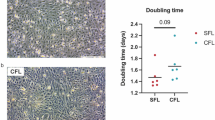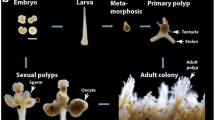Summary
The prelabeled-donor technique was used to study metabolic cooperation in the established cell lines, RTG-2, FHM, and IgH-2, which are respectively from rainbow trout, fathead minnow, and green iguana. The donors were grown with [3H]hypoxanthine for 3 h after which the radioactive medium was removed and the recipients, marked by the presence of latex beads, were added. Cells from each of these lines were capable of cooperating with themselves and with one another because after 5.5 h the recipients in contact with donors were more significantly labeled than those that were not in contact. Cells FHM and IgH-2 were grown with HGPRT− Chinese hamster fibroblasts, CHW-1102, in the presence of [3H]hypoxanthine. In all cases the CHW-1102 cells that were in contact with the non-mammalian cells were more heavily labeled than those that were not in contact. Thus cells from a fish and a reptile undergo metabolic cooperation with cells from a mammal.
Similar content being viewed by others
References
Loewenstein, W. R. Junctional intercellular communication: the cell-to-cell membrane channel. Physiol. Rev. 61: 829–913; 1981.
Peracchia, C. Structural correlates of gap junction permeation. Bourne, G. H.; Danielli, J. F. eds. International review of cytology. Vol. 66. New York: Academic Press; 1980: 81–146.
Gilula, N. B.; Reeves, O. R.; Satir, P. Metabolic coupling, ionic coupling, and cell contacts. Nature 235: 262–265; 1972.
Pederson, D. C.; Sheridan, J. D.; Johnson, R. G. The development of metabolite transfer between reaggregating Novikoff Hepatoma cells. Exp. Cell Res. 127: 159–177; 1980.
Michalke, W.; Loewenstein, W. R. Communication between cells of different type. Nature 232: 121–122; 1971.
Epstein, M. L.; Gilula, N. B. A study of communication specificity between cells in culture. J. Cell Biol. 75: 769–787; 1977.
Hooper, M. L.; Subak-Sharpe, J. H. Metabolic cooperation between cells. Bourne, G. H.; Danielli, J. F. eds. International review of cytology. Vol. 69. New York: Academic Press; 1981: 45–104.
Subak-Sharpe, J. H.; Burk, R. R.; Pitts, J. P. Metabolic co-operation by cell-to-cell transfer between genetically different mammalian cells in tissue culture (abstr.). Heredity 21: 342; 1966.
Pitts, J. D.; Simms, J.W. Permeability of junctions between animal cells: intercellular transfer of nucleotides but not macromolecules. Exp. Cell Res. 104: 153–163; 1977.
Wolf, K.; Quimby, M. C. Established eurythermic line of fish cells in vitro. Science 135: 1065–1066; 1962.
Gravell, M.; Malsberger, R. G. A permanent cell line from the fathead minnow (Pimephales promelas). Ann. NY Acad. Sci. 126: 555–565; 1965.
Clark, H. F.; Cohen, M. M.; Karzon, D. T. Characterization of reptilian cell lines established at incubation temperatures of 23 to 36°C. Proc. Soc. Exp. Biol. Med. 133: 1039–1047; 1970.
Lin, C. C.; Chang, T. D.; Niewczas-Late, V. The establishment of chromosome analysis of a new cell line of Chinese hamster from spontaneous transformationin vitro. Can. J. Genet. Cytol. 13: 4–13; 1971.
Ford, D. K.; Yerganian, G. Observations on the chromosomes of Chinese hamster cells in tissue culture. J. Natl. Cancer Inst. 21: 393–425; 1958.
Bols, N. C.; Mosser, D. D. Separation by thinlayer chromatography of nucleotides from bases and nucleosides in trichloroacetic acid extracts of cells. J. Chromatogr. 229: 460–463; 1982.
Hilwig, I.; Gropp, A. pH-Dependent fluorescence of DNA and RNA in cytologic staining with “33258 Hoechst”. Exp. Cell Res. 91: 457–460; 1975.
Zar, J. H. Biostatistical analysis. Englewood Cliffs: Prentice-Hall; 1974: 109.
Gaunt, S. J.; Subak-Sharpe, J. H. Selectivity in metabolic cooperation between cultured mammalian cells. Exp. Cell Res. 120: 307–320; 1979.
Chen, T. R. In situ detection of mycoplasma contamination in cell cultures by fluorescent Hoescht H33258 stain. Exp. Cell.Res. 104: 255–262; 1977.
Thomas, M. A.; Shipman, C.; Sandberg, J. N.; Drach, J. C. Adenosine phosphorylase activity in a mutant HEp-2 cell line contaminated withMycoplasma hyorhinis. In Vitro 13: 502–509; 1977.
Slack, C.; Morgan, H. M.; Hooper, M. L. Isolation of metabolic cooperation—defective variants from mouse embryonal carcinoma cells. Exp. Cell Res. 117: 195–205; 1978.
Hooper, M. L.; Perry, J. E. Incidence of gap junctions and microvilli in variant cell lines with altered capacity for metabolic co-operation. Exp. Cell Res. 128: 461–466; 1980.
Kelly, R. O.; Vogel, K. G.; Crissman, H. A.; Lujan, C. J.; Skipper, B. E. Development of the aging cell surface. Exp. Cell Res. 119: 127–143; 1979.
Yancey, S. B.; Edens, J. E.; Trosko, J. E.; Chang, C-C.; Revel, J-P. Decreased incidence of gap junctions between Chinese hamster V-79 cells upon exposure to the tumor promoter 12-0-tetradecanoyl phorbol-13-acetate. Exp. Cell Res. 139: 329–340; 1982.
Cox, R. P.; Krauss, M. R.; Balis, M. E.; Dancis, J. Studies on cell communication with enucleated human fibroblasts. J. Cell Biol. 71: 693–703; 1976.
Bols, N. C.; Ringertz, N. R. A study of metabolic cooperation with established myoblast cell lines. Exp. Cell Res. 120: 15–23; 1979.
Hunter, G. K.; Pitts, J. D. Non-selective junctional communication between some different mammalian cell types in primary culture. J. Cell Sci. 49: 163–175; 1981.
Wolf, K.; Mann, J. A. Poikilotherm vertebrate cell lines and viruses: a current listing for fishes. In Vitro 16: 168–179; 1980.
Wolf, K.; Quimby, M. C. Fish cell and tissue culture. Hoar, W. S.; Randall, D. F. eds. Fish physiology. Vol. 3. New York: Academic Press; 1969: 253–305.
Fentiman, I.; Taylor-Papadimitriou, J.; Stoker, M. Selective contact-dependent cell communication. Nature 264: 760–762; 1976.
McKay, I. A.; Taylor-Papadimitriou, J. Junctional communication pattern of cells cultured from human milk. Exp. Cell Res. 134: 465–470; 1981.
Pitts, J. D.; Burk, R. R. Specificity of junctional communication between animal cells. Nature 264: 762–764; 1976.
Author information
Authors and Affiliations
Additional information
This work was supported by a grant from the NSERC of Canada to NCB.
Rights and permissions
About this article
Cite this article
Slater, M.A., Mosser, D.D. & Bols, N.C. Established cell lines from different groups of vertebrates undergo metabolic cooperation with one another. In Vitro 19, 683–692 (1983). https://doi.org/10.1007/BF02628959
Received:
Accepted:
Issue Date:
DOI: https://doi.org/10.1007/BF02628959




